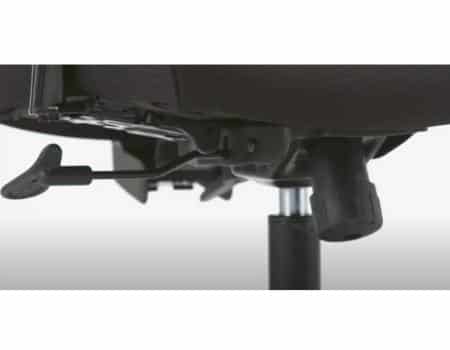Whether you are an office employee or a gaming enthusiast, the one thing used extensively in both cases is the office or gaming chair.
These chairs are designed to provide a comfortable sitting position for hours-long sessions. They are loaded with multiple designs and comfort features.
But sometimes, these functions do not work properly due to malfunction in different components; the most common of all is the tilt tension knob not working.
The problem is tilt knob restricts the chair to tilt; tilting is necessary for office chairs as it provides relief by changing the sitting posture.
Tilting is an ergonomic feature that provides comfort by adjusting or changing an individual’s posture. The comfortability eventually leads to more productivity and prevents serious physical conditions in the long run.
How to Know Whether or not Tilt is not working?
The answer is simple; if your chair is not tilting backward, even after pushing it, then it’s pretty sure that there is a problem with the tilting mechanism. Either it’s the tilting knob or the locking of the tilting mechanism.
This fault in tilting is fixed by servicing or by doing necessary repairs. Below are some instructions, methods, and procedures that help fix tilt tension.
Locating Tilt knob:
The tilt knob is generally located at the bottom of the seat; it is attached to the base frame of the chair. The best way to understand the tilt mechanism and how it controls the tilting is by reading the instructions manual of the chair.
The instructions manual also helps in doing repairs and figuring out the exact problem causing the problem and helps prevent further damage.
Testing the Recline and Lock, Unlock Tilt Knob:
Before starting any repair, try to figure out the exact problem. The first way to do that is by pushing the back chair outwards.
If the seat remains in the same position, the next step is to recline the chair by pulling the reclining lever. If it’s working properly, it is confirmed that the problem lies with the tilt knob.
Often, the tilt knob gets locked unintentionally; the reclining lever locks the chair movement in most office chairs.
If you pull the recline lever in, it will lock the tilting of the chair, and by pulling it outward, it releases the Tension and regains its tilting mechanism.
If the reclining lever is stuck and doesn’t move inward or outward, there are chances that it locks the tilt knob and refrains it from moving; the easy way to get it right is by fixing the lever and unlocking its tilt knob.
How to Fix the Tilt Knob:

Fixing the tilt knob is easy if you take the proper steps. Once you know the reason behind what causes the Tilt to malfunction, you can fix it by replacing, repairing, and making a few adjustments to the tilt mechanism.
Release the Tension in Knob:
Another reason that prevents the chair from tilting is too much Tension in the tilting knob.
The Tension in the tilting knob is responsible for allowing the chair to tilt to some extent. If the Tension is high, it will restrict movement and tilt even after applying some force.
The best way to release the Tension is by turning the tilt knob anti-clockwise. As for as you start rotating the knob, you will notice that the Tension in the tilt spring also loses up, which eventually makes the chair regain its tilting mechanism.
When losing the tension knob, one important thing is not to loosen up too much. It might damage the tilt mechanism when sudden weight is applied if it loosens too much.
Therefore keep the Tension in the tilt knob to the extent that it will not damage it overall.
Repair and Replacement of Recline Lever:
After inspecting all the possible causes and finding the root cause that makes the tilt mechanism malfunction, it’s time to take action and fix the problem. Due to the reclining lever, it’s simple and easy to replace and repair.
Put the chair upside down and start unbolting the chair base and get access to all the tilt mechanism parts. Check the recline level thoroughly, and note whether it’s broken or dented. If so, replace the old lever and install the new one.
If it’s stuck and not moving, use a large screwdriver and dislodge the lever back to its original position, but this is only fruitful in the lever is not damaged.
Sometimes lubricating the parts does the magic and makes everything smooth again, but applying lubricant before the unfastens the bolts eases the process.
Replacing the Old worn out Recliner spring:
Depending on the chairs’ make and model, the type of recliner spring can be different; usually, there are two types of springs, liner or radial spring. Both are used to hold and create Tension in the tilting mechanism.
These springs are also responsible for preventing unwanted jerking when adjusting the recline; if it doesn’t bring any tension, it’s pretty clear that the spring wears out and is more felt when you release the recline lever lock.
To replace the spring, unfasten the bolts holding the seat and keep it in position. Then remove the casing and outer covering to access the recliner spring and then replace the old worn-out spring with a new one and bolt it back.
Step By Step Process:
Let’s elaborate on the step-by-step process to find and fix the tilting problem of your chair.
- Find the tension knob, most probably located at the bottom, underneath the seat. The location of the knob is the same in-office and gaming chairs.
- Try to adjust the knob by reducing the recline tension. Usually, (+) and (-) symbols are shown on the knob. A positive sign means increasing the Tension in spring, and negative shows losing up the knob and reducing the Tension.
- Check if the reclining lever locks the tilting mechanism and moves it outward to unlock it. Sometimes, all you need is to unlock it by pulling out the lever.
- If the problem still exists and your chair is not tilting, the reclining spring needs replacement or repair.
- The spring can be of different types. It can be linear or radial.
- Opening and unfasten the tilt knob.
- Add lubricant and change the spring with the new one.
- Again add lubricant and bolt it with the seat.
Tips for Making the Process Smooth:
Before starting any repairing, check the position and placement of different components. For more accuracy, take a picture with your cellphone for better remembrance.
- Use a drill machine or wrench for unbolting and making the process efficient.
- Use lubricant and apply it on all bolts, springs, and other components to make them lubricated and rust-free.
- Remove all parts properly, clean them, and return them after proper lubrication.
- Read the product manual for a better understanding. It will provide all the information and instructions to follow while repairing and replacing components.
Conclusion:
Tilting and reclining functionalities are necessary for making any office or gaming chair comfortable and best for working long hours. It helps maintain the posture and is beneficial in keeping the ergonomics.
The tilting mechanism of the chair provides a break from sitting in the same posture, helps in relaxing, and leads all the way to increase focus and productivity of work.
Any fault in it brings inconvenience and breaks the momentum or flow of work. By following simple steps, one can fix this problem and increase the life of their office or gaming chair.
It is advisable to use the try and tested techniques, use proper tools and read the instructions manual before making any changes.

I’m Justin Allen, found of mychairreviews.com where I review gaming chairs, massage chairs, recliners for people who are looking to buy one. I love writing things on the internet and blogging about anything that interests me which is usually video games, technology, or sports-related items. When I am not working on blog posts or reviewing products I have a passion for you can find me playing video games with friends online!



